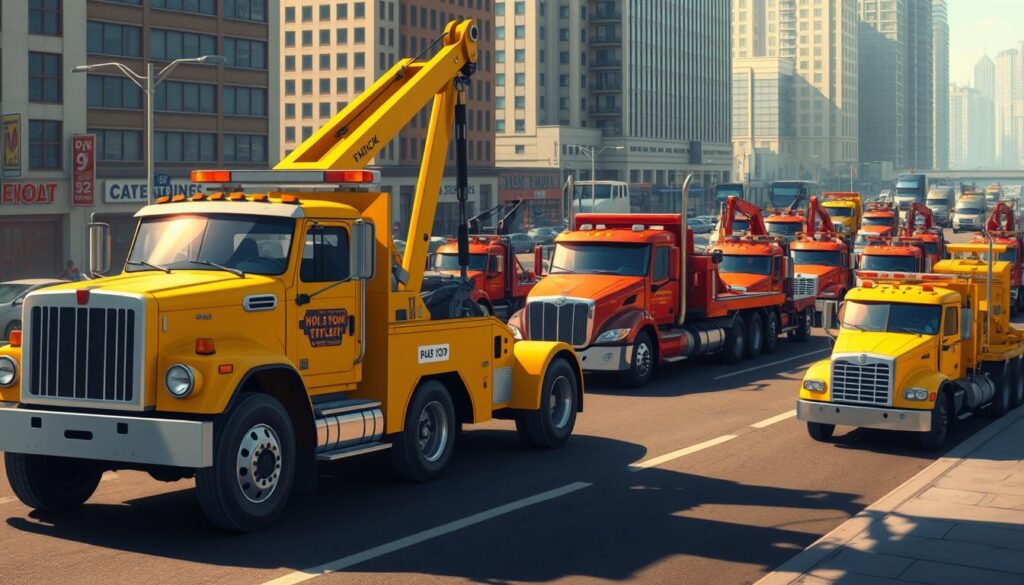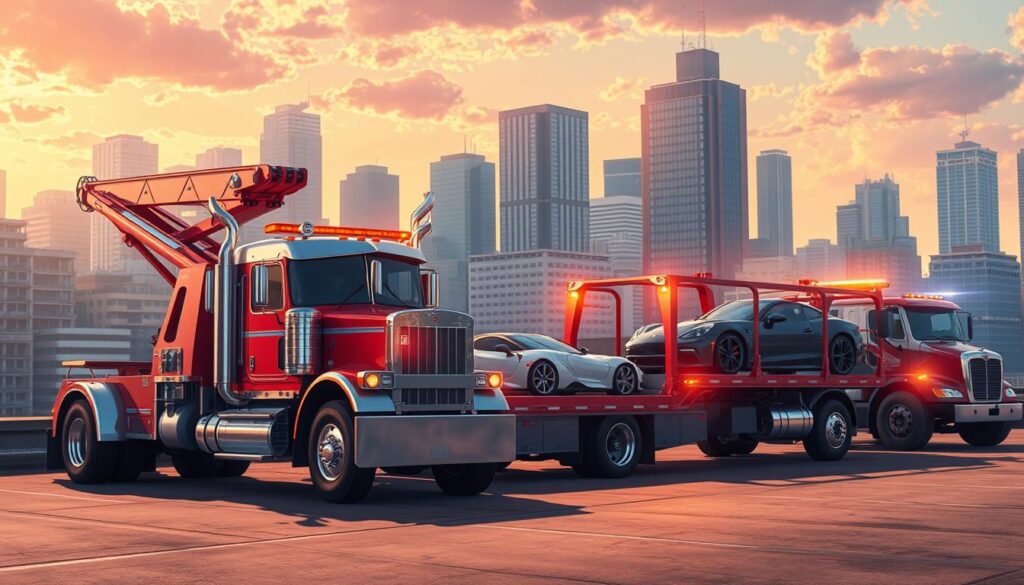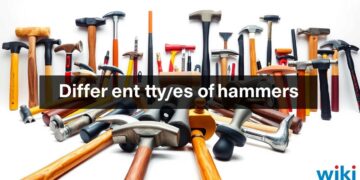Did you know over 45,000 people work in the towing industry in the U.S.? Tow trucks are key to keeping our roads safe. They move disabled or wrongly parked vehicles efficiently.
We use these vehicles every day, often not knowing how complex and varied they are. There are flatbed, wheel-lift, and hook and chain models. Each type of tow truck is made for specific jobs, showing the industry’s diversity and focus.
Knowing the different types is important for those who need towing services. This article will help you understand the 7 essential tow truck classifications. We’ll look at their unique features and uses.
Key Takeaways
- Overview of the 7 essential tow truck classifications.
- Understanding the specific applications of each type.
- Features that distinguish one type from another.
- Importance of choosing the right tow truck for your needs.
- Insights into the towing industry’s diversity and complexity.
Understanding Tow Trucks: An Overview
It’s key to know about tow trucks to get the full picture of vehicle recovery. Tow trucks are specialized vehicles made to tow, lift, and move cars that can’t move or are parked wrong. They vary in size and power, each made for a certain towing need.
Definition of Tow Trucks
Tow trucks are cars made to move other cars that can’t move or are parked wrong. They range from small to big, each with special tools for different jobs.
They have winches, booms, and wheel-lifts to safely move cars. This makes them useful for many tasks, like helping on the road or moving accident cars.
Importance in Vehicle Recovery
Tow trucks are very important for getting cars back on the road. They offer critical roadside assistance, keeping roads safe by moving disabled cars. They also help move cars from accidents to repair shops or lots.
They help keep traffic moving by removing cars that block the way. Their quick action helps avoid more accidents and keeps roads open.
Knowing about tow trucks helps us see how complex and vital car recovery services are. Whether it’s a small tow truck or a big rotator for huge trucks, there’s a tow truck for every job.
Classifying Tow Trucks: The Main Categories
Knowing the different types of tow trucks is key for effective vehicle recovery. Tow trucks fall into three main groups. These groups are based on their towing power and the vehicles they can handle.
Light-Duty Tow Trucks
Light-duty tow trucks are for smaller vehicles like cars and vans. They work best when the vehicle is light and easy to move.
Key Features:
– Good for vehicles up to 3,500 kg
– Compact for tight spaces
– Often used for roadside help and local towing
Medium-Duty Tow Trucks
Medium-duty tow trucks are a middle ground. They can handle bigger vehicles like small trucks and buses.
Capabilities:
– Handles vehicles from 3,500 kg to 7,000 kg
– Versatile for many towing tasks, including accident recovery
– Has more powerful winches and bigger towing gear
Heavy-Duty Tow Trucks
Heavy-duty tow trucks are the strongest. They are made for big commercial vehicles, like semi-trucks and construction gear.
Specifications:
– Tows vehicles over 7,000 kg
– Has heavy-duty winches and advanced systems
– Needed for heavy recovery and complex towing
To understand the differences, let’s compare:
| Tow Truck Category | Towing Capacity | Typical Use |
|---|---|---|
| Light-Duty | Up to 3,500 kg | Cars, vans, and small vehicles |
| Medium-Duty | 3,500 kg – 7,000 kg | Small trucks, buses, and medium-sized vehicles |
| Heavy-Duty | Over 7,000 kg | Large commercial vehicles, semi-trucks, and heavy equipment |
Knowing these categories helps you choose the right tow truck. Whether it’s a small car or a big truck, there’s a tow truck for the job.
Flatbed Tow Trucks: Versatile and Reliable
Flatbed tow trucks are known for being flexible and trustworthy. They have a flat, open bed. This bed can tilt or slide back to the ground, making it easy to load vehicles.
They are great for moving cars that are broken or can’t move on their own. The flatbed keeps the car safe, preventing more damage during transport.
Features of Flatbed Tow Trucks
Flatbed tow trucks have important features that help them work well. Some key features include:
- Hydraulic Systems: These control the flatbed, making it simple to load and unload cars.
- Winches: Winches help pull cars onto the flatbed, especially if they can’t move.
- Straps and Chains: These keep the car safe on the flatbed, ensuring it’s transported securely.
Benefits of Using Flatbed Tow Trucks
Using flatbed tow trucks has many advantages. They provide a safe way to move cars, lowering the chance of damage. They can handle many types of vehicles, from small cars to big equipment.
| Vehicle Type | Towing Method | Benefits |
|---|---|---|
| Cars and Small SUVs | Driven or Winched onto Flatbed | Safe, Secure, Minimal Risk of Damage |
| Heavy Equipment | Winched onto Flatbed | Versatile, Handles Heavy Loads |
| Damaged Vehicles | Winched onto Flatbed | Prevents Further Damage, Safe Transport |
Knowing about flatbed tow trucks helps you choose the right one for your needs. They’re perfect for moving damaged cars or heavy equipment. They’re a dependable choice.
Hook and Chain Tow Trucks: The Classic Choice
The hook and chain system is one of the oldest in towing. For years, it’s been key in getting vehicles back on the road after accidents.
Hook and chain tow trucks use a simple yet effective way to tow. They lift and tow with a metal hook and chains. The chains wrap around the vehicle’s axle or frame, then hook to the truck. This method lifts and moves the vehicle to its new spot.
How Hook and Chain Tow Trucks Work
Hook and chain tow trucks work in a straightforward way. First, the tow truck pro checks the situation to figure out the best way to tow. Then, chains wrap around the vehicle’s axle or frame. The metal hook is attached, and the tow truck can start pulling.
Key steps in the process include:
- Assessing the vehicle’s condition and determining the best towing method.
- Securing the chains around the vehicle’s axle or frame.
- Attaching the metal hook to the chains and ensuring everything is secure.
- Lifting and towing the vehicle to the desired location.
Pros and Cons of Hook and Chain Systems
Hook and chain tow trucks have good and bad points. They’re often cheaper than other methods and work well for some vehicles.
Pros:
- Cost-effective: They’re less expensive to run and keep up.
- Effective for certain vehicles: Great for older cars or those with special needs.
Cons:
- Potential for damage: Chains can harm the vehicle’s frame or body if not careful.
- Limited applicability: Not good for all vehicles, especially newer ones.
Knowing the pros and cons helps decide when to use hook and chain tow trucks. They’re not for every situation but work well for some.

Wheel-Lift Tow Trucks: Compact Solutions
Wheel-lift tow trucks are great for those needing a strong and precise towing solution. They are made to be compact and efficient. This makes them perfect for many recovery situations.
Operation of Wheel-Lift Tow Trucks
These trucks use a hydraulic system to lift a vehicle’s wheels. This makes towing safe and stable, reducing damage risk. It’s easy to use: just deploy the hydraulic lift and secure it.
Key Features of Wheel-Lift Tow Trucks:
| Feature | Description | Benefit |
|---|---|---|
| Hydraulic System | Lifts the vehicle’s wheels off the ground | Reduces risk of damage during towing |
| Compact Design | Allows for maneuverability in tight spaces | Ideal for urban and roadside recovery |
| Versatility | Can be used for various vehicle types | Suitable for different recovery needs |
When to Use a Wheel-Lift Tow Truck
Wheel-lift tow trucks are great in tight spaces, like cities or roadside. They’re also good when the vehicle isn’t badly damaged. For more info, check out this resource.
Integrated Tow Trucks: Multi-Purpose Power
Integrated tow trucks combine towing and truck chassis into one strong unit. This makes them perfect for heavy towing and complex recovery jobs. They are very stable and strong.
Design of Integrated Tow Trucks
The design of these tow trucks puts towing equipment right into the truck’s body. This integration brings many benefits. It improves stability, boosts towing power, and increases performance.
With the towing and chassis as one, these trucks can tackle tough recovery jobs better. They also have better weight distribution. This is key when moving heavy loads.
Applications in Heavy-Duty Situations
Integrated tow trucks are great for heavy-duty jobs where regular tow trucks can’t handle it. They’re used to pull big vehicles like buses and heavy construction gear. They’re also key in complex recovery jobs that need a lot of power.
These trucks are also top picks for tough road conditions. This includes rough terrains or bad weather. Their enhanced stability and towing power make them the go-to for pros in tough situations.
In short, integrated tow trucks are a strong answer for heavy towing needs. They offer a mix of power, stability, and flexibility that’s hard to beat with other tow trucks.
Rotator Tow Trucks: The Ultimate in Recovery
Rotator tow trucks are the top in recovery tech. They can handle tough towing jobs with ease. These vehicles are made for the most challenging recovery tasks.
Capabilities of Rotator Tow Trucks
These trucks have a rotating boom that turns 360 degrees. This lets them tackle complex recovery jobs. They also have heavy-duty winches for pulling heavy loads.
- 360-Degree Rotation: Enables operators to maneuver vehicles into position from any angle.
- Heavy-Duty Winches: Capable of pulling heavy loads, making them suitable for large vehicle recovery.
- Advanced Control Systems: Allows for precise control during recovery operations.
For more details on rotator tow trucks, visit this page. It talks about their top-notch towing skills.
Situations Requiring Rotator Tow Trucks
Rotator tow trucks are needed for tough jobs. Other tow trucks can’t handle these tasks. Here are some examples:
| Situation | Description | Why Rotator Tow Trucks are Ideal |
|---|---|---|
| Complex Recovery Operations | Recovering vehicles from hard-to-get places or in tricky positions. | Their 360-degree boom and strong winches are perfect for these jobs. |
| Heavy-Duty Recovery | Getting big or heavy vehicles like buses, trucks, or construction gear. | They have the power and tools to lift heavy loads. |
| Emergency Response | Quickly fixing accidents or incidents where fast recovery is key. | Their advanced tech lets them act fast and solve problems quickly. |
Rotator tow trucks are key in the towing world. They have the skills to deal with many recovery jobs. Their advanced features and strength make them the best for tough towing tasks.
Specialty Tow Trucks: Customized for Unique Tasks
Specialty tow trucks are perfect for towing vehicles that are not like regular cars. They can handle motorcycles, heavy equipment, and more. These trucks make towing safe and easy for special vehicles.
Specialty tow trucks are key for unique vehicles and equipment. They help with motorcycles, ATVs, and heavy machinery. Each truck is made for a specific need.
Tow Trucks for Motorcycles and ATVs
Towing motorcycles and ATVs is different from regular cars. Specialized tow trucks for motorcycles and ATVs have special features. These include:
| Feature | Description | Benefit |
|---|---|---|
| Soft straps | Gently secure the vehicle | Prevents damage to the vehicle |
| Wheel chocks | Stabilize the vehicle during transport | Ensures safe transportation |
| Customized carriers | Designed to fit specific models | Provides a secure fit |
For more info on specialty towing, including motorcycles and ATVs, check out Precision Towing LLC’s Specialty Towing page.
Tow Trucks for Heavy Equipment
Heavy equipment like construction and farm gear needs strong towing. Tow trucks for heavy equipment are built tough. They have:

- High-capacity winches
- Reinforced structures
- Advanced stabilization systems
These features help move heavy equipment safely. They reduce the chance of damage or accidents.
Safety Features in Tow Trucks: What to Look For
When looking at tow truck options, safety is key. It ensures safe recovery. Knowing the safety features of tow trucks is important.
Importance of Safety Features
Safety features protect everyone involved in towing. They prevent accidents and make recovery smooth. Advanced safety features lower the risk of damage or injury.
Tow trucks have many safety features. These include warning lights, safety chains, and securement systems. These show the industry’s focus on safety.
Common Safety Features in Tow Trucks
Each tow truck model has its own safety features. Some common ones are:
| Safety Feature | Description | Benefit |
|---|---|---|
| Warning Lights | Flashing lights to alert other drivers | Increased visibility |
| Safety Chains | Additional security to prevent detachment | Enhanced safety during towing |
| Securement Systems | Systems to securely fasten the vehicle | Prevents vehicle shifting during transport |
Knowing about safety features helps you choose the right tow truck. This is important for your needs.
Selecting the Right Tow Truck: Key Considerations
Choosing the right tow truck is about knowing what you need. Look at the vehicle’s type, size, and weight. Also, think about the terrain and the situation to pick the best truck.
Assessing Recovery Needs
It’s important to know what you need for the recovery. For big vehicles, you might need a rotator or integrated tow truck. For smaller ones, a wheel-lift or flatbed might be better.
Budget and Cost Considerations
Your budget is key in choosing a tow truck. Different types cost differently. So, think about what you need and what you can afford. This way, you can find a tow truck that fits your needs.



















